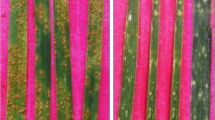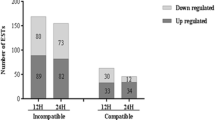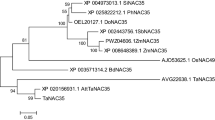Abstract
In Arabica coffee breeding, some of the most used sources of resistance to leaf rust (Hemileia vastatrix) are natural Coffea arabica x canephora hybrids (“Híbrido de Timor”). To decipher the cellular and molecular nature of that resistance, leaves of genotype HDT832/2, were challenged with H. vastatrix race II, and monitored using light microscopy and RT-qPCR expression analysis of genes involved in plant immunity mechanisms (receptor-like kinase, WRKY transcription factor 1, phenylalanine ammonia-lyase, chalcone synthase, 13-lipoxygenase, glycosyltransferase, pathogenesis related PR1b and PR10). These were compared to the nonhost resistance responses of HDT832/2 to the infection by the cowpea rust fungus (Uromyces vignae). H. vastatrix ceased growth more frequently after stomata penetration, forming few haustoria, inducing a hypersensitive-like response, phenol accumulation and haustorium encasement with callose. U. vignae could enter stomata but failed to form haustoria, while inducing hypersensitive-like responses and phenol accumulation. In host and nonhost interactions, activation of genes involved in signalling coincided with the differentiation of appressoria, and cellular responses (hypersensitive-like responses and accumulation of phenolic compounds) were recorded from the full appressorium or penetration hypha stages onwards. Similarly, a gene related to the JA pathway was first activated at the penetration hypha stage for both interactions, while genes related to the SA pathway were only activated in the host interaction, the latter being the single clear difference between host and nonhost interactions. The cellular and molecular resistance responses of HDT832/2 to these rust fungi suggest that common immunity components are shared between host and nonhost resistance, which may explain the longer durability of this resistance.






Similar content being viewed by others
Abbreviations
- An:
-
Anchor
- Ap:
-
Appressorium
- bp:
-
base pair
- CHS:
-
Chalcone Synthase
- CIFC:
-
Coffee Rusts Research Center/Tropical Research Institute
- ETI:
-
Effector-Triggered Immunity
- GAPDH:
-
Glyceraldehyde 3-Phosphate Dehydrogenase
- GT:
-
Glycosyltransferase
- hai:
-
hours after inoculation
- HDT:
-
Timor Hybrid (Híbrido de Timor)
- HMC:
-
Haustorial Mother Cell
- HR:
-
Hypersensitive Response
- IH:
-
Infection hypha
- JA:
-
Jasmonic Acid
- LOX:
-
Lipoxygenase
- PAL:
-
L- phenylalanine Ammonia-Lyase
- PAMP:
-
Pathogen-Associated Molecular Patterns
- PH:
-
penetration hypha
- PR:
-
Pathogenesis-Related
- PTI:
-
PAMP-Triggered Immunity
- R:
-
resistance gene/protein
- RLK:
-
Receptor-Like Kinase
- RT-qPCR:
-
Reverse Transcription-quantitative Polymerase Chain Reaction
- SA:
-
Salicylic Acid
- SV:
-
substomatal vesicle
- u.v.:
-
ultra-violet light
References
Azinheira, H. G., Silva, M. C., Talhinhas, P., Medeira, C., Maia, I., Petitot, A.-S., & Fernandez, D. (2010). Arabidopsis thaliana non-host resistance responses to the coffee leaf rust fungus (Hemileia vastatrix). Botany, 88, 621–629.
Barsalobres-Cavallari, C. F., Severino, F. E., Maluf, M. P., & Maia, I. G. (2009). Identification of suitable internal control genes for expression studies in Coffea arabica under different experimental conditions. BMC Molecular Biology, 10, 1.
Bennett, M., Gallagher, M., Fagg, J., Bestwick, C., Paul, T., Beale, M., & Mansfield, J. (1996). The hypersensitive reaction, membrane damage and accumulation of autofluorescent phenolics in lettuce cells challenged by Bremia lactucae. The Plant Journal, 9, 851–865.
Bettencourt, A. J., & Rodrigues, C. J., Jr. (1988). Principles and practice of coffee breeding for resistance to rust and other diseases. In R. J. Clarke & R. Macrae (Eds.), Coffee Agronomy Vol. 4 (pp. 199–234). London and New York: Elsevier Applied Science Publishers LTD.
Christopher-Kozjan, R., & Heath, M. C. (2003). Cytological and pharmacological evidence that biotrophic fungi trigger different cell death execution processes in host and nonhost cells during the hypersensitive responses. Physiological and Molecular Plant Pathology, 62, 265–275.
Cruz, F., Kalaoun, S., Nobile, P., Colombo, C., Almeida, J., Barros, L. M. G., Romano, E., Grossi-de-Sá, M. F., Vaslin, M., & Alves-Ferreira, M. (2009). Evaluation of coffee reference genes for relative expression studies by quantitative real-time RT-PCR. Molecular Breeding, 23, 607–616.
D’Oliveira, B. (1954-57). As ferrugens do cafeeiro. Revista do Café Português, 1(4), 5-13, 2(5), 5-12, 2(6), 5-15 ,2(7), 9-187, 2(8), 5-22, 4(16), 5-15
Diniz, I., Talhinhas, P., Azinheira, H. G., Várzea, V., Oliveira, H., Fernandez, D. & Silva, M. C. (2010). Cellular and molecular responses in host and nonhost coffee-rust interactions (Hemileia vastatrix and Uromyces vignae). (In Proceedings of the 23 rd International Conference on Coffee Science (ASIC), 3-8 October 2010, (pp. 748-753). Bali)
Dorey, S., Baillieul, F., Pierrel, M. A., Saindrenan, P., Fritig, B., & Kauffmann, S. (1997). Spatial and temporal induction of cell death, defense genes, and accumulation of salicylic acid in tobacco leaves reacting hypersensitively to a fungal glycoprotein elicitor. Molecular Plant-Microbe Interactions, 10, 646–655.
Eschrich, W., & Currier, H. B. (1964). Identification of callose by its diachrome and fluochrome reactions. Stain Technology, 39, 303–304.
Eulgem, T., & Somssich, I. (2007). Networks of WRKY transcription factors in defense signaling. Current Opinion in Plant Biology, 10, 366–371.
Fernandez, D., Santos, P., Agostini, C., Bon, M.-C., Petitot, A.-S., Silva, M. C., Guerra-Guimarães, L., Ribeiro, A., Argout, X., & Nicole, M. (2004). Coffee (Coffea arabica L.) genes early expressed during infection by the rust fungus (Hemileia vastatrix). Molecular Plant Pathology, 5, 527–536.
Fernandez-Aparicio, M., Barilli, E., Mansilla, F., & Rubiales, D. (2011). Identification and characterisation of resistance against rust (Puccinia allii) in garlic (Allium sp.) germplasm. Annals of Applied Biology, 159, 93–98.
Ganesh, D., Petitot, A., Silva, M. C., Alary, R., Lecouls, A. C., & Fernandez, D. (2006). Monitoring of the early molecular resistance responses of coffee (Coffea arabica L.) to the rust fungus (Hemileia vastatrix) using real-time quantitative RT-PCR. Plant Science, 170, 1045–1051.
Guzzo, S. D., Harakava, R., & Tsai, S. M. (2009). Identification of coffee genes expressed during systemic acquired resistance and incompatible interaction with Hemileia vastatrix. Journal of Phytopathology, 157, 625–638.
Halim, V., Altmann, S., Ellinger, D., Eschen-Lippold, L., Miersch, O., Scheel, D., & Rosahl, S. (2009). PAMP-induced defense responses in potato require both salicylic acid and jasmonic acid. The Plant Journal, 57, 230–242.
Heath, M. C. (1974). Light and electron microscope studies of the interactions of host and nonhost plants with cowpea rust - Uromyces phaseoli var. vignae. Physiological and Molecular Plant Pathology, 4, 403–414.
Heath, M. C. (1984). Relationship between heat-induced fungal death and plant necrosis in compatible and incompatible interactions involving the bean and cowpea rust fungi. Pthytopathology, 74, 1370–1376.
Heath, M. C. (1998). Involvement of reactive oxygen species in the response of resistant (hypersensitive) or susceptible cowpeas to the cowpea rust fungus. New Phytologist, 138, 251–263.
Heath, M. C. (2000). Nonhost resistance and non-specific plant defenses. Current Opinion in Plant Biology, 3, 315–319.
Horvath, D. M., & Chua, N. H. (1996). Identification of an immediate-early salicylic acid-inducible tobacco gene and characterization of induction by other compounds. Plant Molecular Biology, 31, 1061–1072.
Jones, J. D. G., & Dangl, J. L. (2006). The plant immune system. Nature, 444, 323–329.
Lipka, U., Fuchs, R., & Lipka, V. (2008). Arabidopsis non-host resistance to powdery mildews. Current Opinion in Plant Biology, 11, 404–411.
Livak, K. J., & Schmittgen, T. D. (2001). Analysis of relative gene expression data using real-time quantitative PCR and the 2-ΔΔCT method. Methods, 25, 402–408.
Loehrer, M., Langenbach, C., Goellner, K., Conrath, U., & Schaffrath, U. (2008). Characterization of nonhost resistance of Arabidopsis to the Asian soybean rust. Molecular Plant-Microbe Interactions, 21, 1421–1430.
Lyngkjaer, M. F., Newton, A. C., Atzema, J. L., & Baker, S. J. (2000). The balrley mlo gene: an important powdery mildew resistance source. Agronomie, 20, 745–756.
Madrid, E., Gil, J., Rubiales, D., Krajinski, F., Schlereth, A., & Millán, T. (2010). Transcription factor profiling leading to the identification of putative transcription factors involved in the Medicago truncatula – Uromyces striatus interaction. Theoretical and Applied Genetics, 12, 1311–1321.
Mellersh, D. G., & Heath, M. C. (2003). An investigation into the involvement of defense signaling pathways in components of the nonhost resistance of Arabidopsis thaliana to rust fungi also reveals a model system for studying rust fungal compatibility. Molecular Plant-Microbe Interactions, 16, 398–404.
Morris, E. R., & Walker, J. (2003). Receptor-like protein kinases: the keys to response. Current Opinion in Plant Biology, 6, 339–342.
Niks, R. E., & Rubiales, D. (2002). Potentially durable resistance mechanisms in plants specialised fungal pathogens. Euphytica, 124, 201–216.
Parlevliet, J. E. (1983). Models explaining the specificity and durability of host resistance derived from the observations on the barley – Puccinia hordei system. In F. Lamberti, J. M. Wallen, & N. A. van Graaff (Eds.), Durable Resistance in Crops (pp. 57–80). New York: Plenum Press.
Petitot, A.-S., Lecouls, A.-C., & Fernandez, D. (2008). Sub-genomic origin and regulation patterns of a duplicated WRKY gene in the allotetraploid species Coffea arabica. Tree Genetics and Genomes, 4, 379–390.
Prakash, N., Bhat, S. S., Hanumantha, B. T., Várzea, V. M. P., Marques, D., Silva, M. C. & Jayarama (2010). Break down of rust resistance in some HdT introductions and its derivatives in India-New challenges for Arabica coffee breeding in the light of increasing pathogen virulence. (Poster presented at the 23 rd International Conference on Coffee Science (ASIC), 3-8 October 2010, Bali.)
Prats, E., Martinez, F., Rojas-Molina, M. M., & Rubiales, D. (2007). Differential effects of phenylalanine ammonia lyase, cynnamyl alcohol dehydrogenase, and energetic metabolism inhibition on resistance of appropriate hostand nonhost cereal – rust interactions. Phytopathology, 97, 1578–1583.
Ramiro, D., Escoute, J., Petitot, A. S., Nicole, M., Maluf, M., & Fernandez, D. (2009). Biphasic haustorial differentiation of the orange rust Hemileia vastatrix race II associated with differential defense responses in resistant coffee cultivar. Plant Pathology, 58, 944–955.
Ramiro, D., Jalloul, A., Petitot, A.-S., Maluf, M., & Fernandez, D. (2010). Identification of coffee WRKY transcription factor genes and expression profiling in resistance responses to pathogens. Tree Genetics and Genomes, 6, 767–781.
Rijo, L., Rodrigues, C. J., Jr., & Vasconcelos, M. I. (1982). Immunity on the coffee-orange rust association. Histopathological aspects. Garcia de Orta, 9, 101–104.
Rodrigues, C. J., Jr., Bettencourt, A. J., & Rijo, L. (1975). Races of the pathogen and resistance to coffee rust. Annual Review of Phytopathology, 13, 49–70.
Rubiales, D., & Niks, R. E. (1995). Characterization of Lr34, a major gene conferring nonhypersensitive resistance to wheat leaf rust. Plant Disease, 79, 1208–1212.
Silva, M. C. (1996). Estudos histológicos e de ultrastrutura em interacções de Coffea spp. e espécies não hospedeiras com Hemileia vastatrix, e de Coffea arabica com ferrugens não patogénicas. Dissertation, Universidade Técnica de Lisboa (Instituto Superior de Agronomia), Lisbon
Silva, M. C., Nicole, M., Rijo, L., Geiger, J. P., & Rodrigues, C. J. (1999). Cytochemistry of plant-rust fungus interface during the compatible interaction Coffea arabica (cv. Caturra)-Hemileia vastatrix (race III). International Journal of Plant Sciences, 160, 79–91.
Silva, M. C., Nicole, M., Guerra-Guimarães, L., & Rodrigues, C. J., Jr. (2002). Hypersensitive cell death and post-haustorial defence responses arrest the orange rust (Hemileia vastatrix) growth in resistant coffee leaves. Physiological and Molecular Plant Pathology, 60, 169–183.
Silva, M. C., Várzea, V., Guerra-Guimarães, L., Azinheira, H. G., Fernandez, D., Petitot, A.-S., Bertrand, B., Lashermes, P., & Nicole, M. (2006). Coffee resistance to the main diseases: leaf rust and coffee berry disease. Brazilian Journal of Plant Physiology, 18, 119–147.
Silva, M. C., Guerra-Guimarães, L., Loureiro, A., & Nicole, M. R. (2008). Involvement of peroxidases in the coffee resistance to orange rust (Hemileia vastatrix). Physiological and Molecular Plant Pathology, 72, 29–38.
Soh, H. C., Park, A. R., Park, S., Back, K., Yoon, J. B., Park, H. G., & Kim, Y. S. (2012). Comparative analysis of pathogenesis-related protein 10 (PR10) genes between fungal resistant and susceptible peppers. European Journal of Plant Pathology, 132, 37–48.
Stark-Urnau, M., & Mendgen, K. (1993). Differentiation of aecidiospore- and uredospore-derived infection structures on cowpea leaves and on artificial surfaces by Uromyces vignae. Canadian Journal of Botany, 71, 1236–1242.
Talhinhas, P., Azinheira, H. G., Loureiro, A., Batista, D., Vieira, B., Pina-Martins, F., Tisserant, E., Petitot, A.-S., Paulo, O. S., Duplessis, S., Silva, M. C. & Fernandez, D. (2010). Overview of the functional virulent genome of the coffee leaf rust pathogen Hemileia vastatrix. (In Proceedings of the 23 rd International Conference on Coffee Science (ASIC), 3-8 October 2010, (pp. 414-422). Bali)
Thomma, B., Penninckx, I., Broekaert, W., & Cammue, B. (2001). The complexity of disease signaling in Arabidopsis. Current Opinion in Immunology, 13, 63–68.
Umemura, K., Junji, S., Michiaki, I., Nobuyuki, U., Jinichiro, K., Tomonori, K., Koshiba, T., Anzai, H., & Mitomi, M. (2009). Contribution of salicylic acid glucosyltransferase, OsSGT1, to chemically induced disease resistance in rice plants. The Plant Journal, 57, 463–472.
Van Loon, L. C., Rep, M., & Pieterse, C. M. J. (2006). Significance of inducible defense-related proteins in infected plants. Annual Review of Phytopathology, 44, 135–162.
Várzea, V. M. P., & Marques, D. V. (2005). Population variability of Hemileia vastatrix vs coffee durable resistance. In L. Zambolim, E. Zambolim, & V. M. P. Várzea (Eds.), Durable resistance to coffee leaf rust (pp. 53–74). Viçosa: Universidade Federal de Viçosa.
Vieira, A., Talhinhas, P., Loureiro, A., Duplessis, S., Fernandez, D., Silva, M. C., Paulo, O. S. & Azinheira, H. G. (2011). Expression profiling of genes involved in the biotrophic colonisation of Coffea arabica leaves by Hemileia vastatrix. European Journal of Plant Pathology, this issue.
Wasternack, C. (2007). Jasmonates: an update on biosynthesis, signal transduction and action in plant stress response, growth and development. Annals of Botany, 100, 1114–1119.
Zabala, G., Zou, J., Tuteja, J., Gonzalez, D., Clough, S. J., & Vodkin, L. (2006). Transcriptome changes in the phenylpropanoid pathway of Glycine max in response to Pseudomonas syringae infection. BMC Plant Biology, 6, 26.
Zang, H.-S., De la Rosa, R., Rubiales, D., Lubbers, H. H., Molenveld, J. W., & Niks, R. E. (1994). Role of partial resistance to Puccinia hordei in barley in the defence of barley to inappropriate rust fungi. Physiological and Molecular Plant Pathology, 45, 219–228.
Zipfel, C., & Robatzek, S. (2010). Pathogen-associated molecular pattern-triggered immunity: veni, vidi…? Plant Physiology, 154, 551–554.
Acknowledgements
This work was financially supported by Fundação para a Ciência e a Tecnologia (Portugal), project PTDC/AGR-AAM/71866/2006 and through a French-Portuguese collaborative project (Partenariat Hubert Curien PHC-Pessoa 22583XM) funded by the Ministère des Affaires Étrangères et Européennes of France. Uromyces vignae uredospores and Vigna unguiculata seeds were kindly given by Professor Kurt Mendgen (Departament of Phytopathology, University of Konstanz, Germany). We also appreciate the technical support provided by Paula Leandro.
Author information
Authors and Affiliations
Corresponding author
Rights and permissions
About this article
Cite this article
Diniz, I., Talhinhas, P., Azinheira, H.G. et al. Cellular and molecular analyses of coffee resistance to Hemileia vastatrix and nonhost resistance to Uromyces vignae in the resistance-donor genotype HDT832/2. Eur J Plant Pathol 133, 141–157 (2012). https://doi.org/10.1007/s10658-011-9925-9
Accepted:
Published:
Issue Date:
DOI: https://doi.org/10.1007/s10658-011-9925-9




